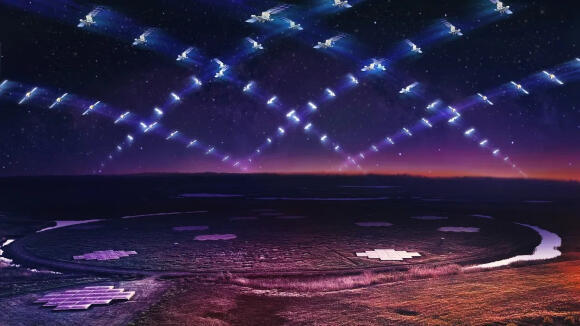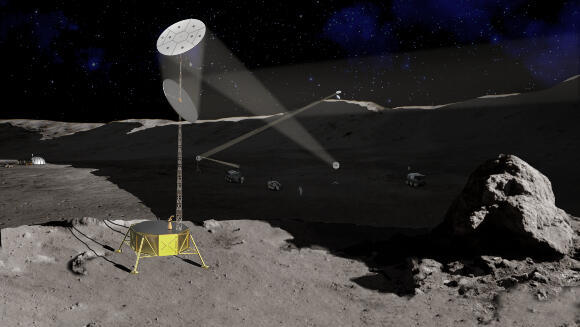Farewell to a workhorse
This week marked the final launch of the heavy-duty European rocket, Ariane 5. Launched on its last-ever mission on July 5 from the European Space Base in Kourou, French Guiana, this rocket was carrying two communication satellites on a trajectory set for a geostationary orbit, where the satellites will hover over a fixed point on Earth.
More stories:
One satellite, Syracuse 4B, belongs to the French military, while the other, Heinrich-Hertz, is owned by the German Space Agency and is designed for experiments and research in communication technologies.
2 View gallery


Starlink satellites in low orbit over the LOFAR radio telescope in the Netherlands
(Photo: Daniëlle Futselaar, NoirLab)
Ariane 5, engineered by the European satellite launch company Arianespace, was developed in the '90s and first launched in 1996. Despite its original design to also carry humans, it ended up never embarking on any manned missions. The large rocket can carry a payload of over ten tons to a geostationary orbit and over twenty tons to a low Earth orbit. Over its 27-year lifespan, 117 Ariane 5 rockets were launched. All of these were single-use, with no component recycling. Out of these launches, 112 were a complete success, two ended in failure, and three were marked as "partial failures".
The last partial failure occurred in 2018 when a malfunction led the rocket to place the satellite on an incorrect trajectory. Nevertheless, satellite operators managed to rectify its trajectory using fuel reserved for the continuation of the mission. Notable passengers of the European rocket include the James Webb Space Telescope, which was launched in December 2021, the Rosetta mission in 2004 - the first spacecraft to enter an orbit around an asteroid, and most recently, the JUICE mission, equipped with an Israeli research device, sent to explore Jupiter and its moons.
The planned successor to this rocket is Ariane 6, which has been under development for almost a decade. Slightly larger and more powerful than its predecessor, it runs on hydrogen and oxygen (with solid fuel boosters), and it is also single-use - with no recycling of components. Its inaugural launch is set for later this year, and plans are already in place for nearly 30 missions intended for launch on this rocket.
Disruptive radio emissions from satellite constellations
The rapid deployment of large groups, incorporating dozens, hundreds, and even thousands of satellites, has significantly increased over the years. Spearheading this trend is SpaceX, whose Starlink communication satellite network currently boasts over 4,000 satellites, projected to exceed 10,000 in the coming years.
However, SpaceX is not alone, as more companies are developing and launching satellite constellations for various purposes, including telecommunications, navigation, weather monitoring, and imaging. Light reflection from these vast satellite groups and their transits across the sky can interfere with astronomical observations, and their communications can disrupt radio telescopes.
While these issues can be mitigated by coordinating orbits and frequencies with satellite operators, new research reveals an unintentional emission of radio waves from satellites, which can potentially interfere with telescopes. This pertains to radiation emitted during the normal operation of the satellite's electronic devices, even when not transmitting to a ground station.
The study, conducted at a radio telescope in the Netherlands, tracked the radiation emitted by Starlink satellite constellations. In an article in the scientific journal Astronomy & Astrophysics, the researchers report that 47 of the 68 tested satellites emitted low-frequency radio waves, between 110 and 188 megahertz, which may disrupt radio telescope measurements. Some of the emissions were also detected between 150 and 153 megahertz, a frequency range reserved for radio telescopes according to International Telecommunication Union regulations. However, these rules only apply to terrestrial transmission facilities, so technically, there is no violation here.
"Our simulations show that the larger the constellation, the more important this effect becomes as the radiation from all the satellites adds up" says co-author Benjamin Winkel from the Max Planck Institute for Radio Astronomy (MPIfR) in Germany. "This makes us worried not only about the existing constellations but even more about the planned ones - and also about the absence of clear regulation that protects the radio astronomy band from unintended radiation.”
Unraveling the history of the universe
Last week, the European Space Agency successfully launched the Euclid Space Telescope. The primary mission of this telescope is to study the expansion of the universe and attempt to decipher the mysteries of dark matter and dark energy. Equipped with a visible light camera and an infrared spectrometer, the telescope aims to measure the redshift of billions of galaxies. This redshift measurement will provide insight into the speed at which these galaxies are moving away from us. Ultimately, the telescope is anticipated to survey approximately a third of the sky and collect data on galaxies situated up to 10 billion light years away.
The telescope's scientific team includes over 2,000 scientists from 300 research institutions across 16 countries - 13 from the European Union, and the remainder from the United States, Canada, and Japan. Their mission will involve analysis of the vast amount of data to be transmitted by Euclid, in order to gain a clearer understanding of the universe's expansion and its change over time.
The telescope, about the size of a commercial vehicle and weighing around two tons, was launched on a SpaceX Falcon 9 rocket on July 1st. From its low Earth orbit, it is currently making its way towards the L2 point, a location where the balance of gravitational forces from Earth and the Sun allows it to remain with almost no energy expenditure. Here it will keep good company by joining other space telescopes, including the James Webb Telescope and the Gaia Telescope.
Named after the ancient Greek mathematician Euclid of Alexandria, hailed as the father of geometry, the Euclid telescope is expected to operate for about six years, in the hope that it will help us better understand the geometry of our universe and its composition.
2 View gallery


Solar power in the darkness. Light Bender system redirecting sunlight towards solar panels deep within a dark lunar crater
(Photo: MAXAR)
Illuminating the lunar darkness
As part of NASA's Artemis program, the United States Space Agency plans to land humans near the south pole of the moon. One key objective of this mission is to investigate the possibility of ice within craters that are perpetually engulfed in shadows, where sunlight does not penetrate. Operating in such permanently shadowed regions poses a significant challenge, as sunlight serves as the primary energy source, for example, to charge the batteries of electrical vehicles and scientific equipment. The American company Maxar recently won a NASA grant to develop a system of mirrors to be placed in a lit area and redirect sunlight to power solar panels located in dark regions of the lunar surface.
The system, named ‘Light Bender’ will consist of a moon lander carrying two mirrors on a 20-meter-high telescopic mast. Once the mast is deployed, one mirror will capture sunlight and reflect it towards the second mirror, which, with the aid of a robotic arm will then direct the sunlight to a distant target situated deep within the shaded area.
This innovative solution will allow astronauts to carry out prolonged operations inside the crater during the lunar day, which lasts approximately two Earth weeks. Maxar, having extensive experience in developing robotic arms for space operations, including those used on Mars rovers, plans to showcase the functionality of the Light Bender system on Earth within two years, before moving on to a trial on the moon itself.
This content was distributed by the Davidson Institute of Science

